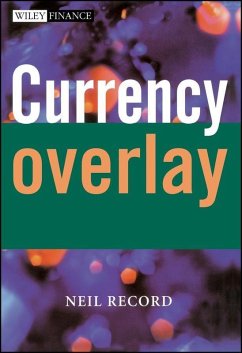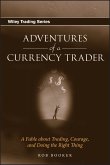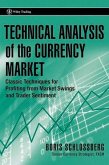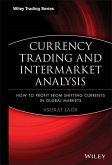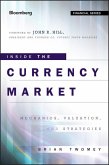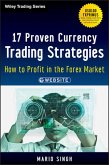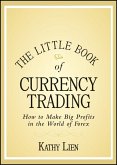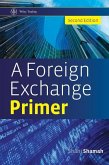Currency Overlay (eBook, PDF)


Alle Infos zum eBook verschenken

Currency Overlay (eBook, PDF)
- Format: PDF
- Merkliste
- Auf die Merkliste
- Bewerten Bewerten
- Teilen
- Produkt teilen
- Produkterinnerung
- Produkterinnerung

Hier können Sie sich einloggen

Bitte loggen Sie sich zunächst in Ihr Kundenkonto ein oder registrieren Sie sich bei bücher.de, um das eBook-Abo tolino select nutzen zu können.
Currency overlay is the management of the currency exposure inherent in cross-border institutional investments. Exposure to foreign currencies increases the volatility of their returns, without increasing the returns themselves and academics and consultants recommended that the currency exposure should be stripped out of international portfolios and eliminated as far as practicable. This book provides a comprehensive description of currency overlay, its history and possible future developments and growth, the reason for its emergence, the debates and controversies, the different styles of…mehr
- Geräte: PC
- mit Kopierschutz
- eBook Hilfe
- Größe: 2.03MB
![Adventures of a Currency Trader (eBook, PDF) Adventures of a Currency Trader (eBook, PDF)]() Rob BookerAdventures of a Currency Trader (eBook, PDF)40,99 €
Rob BookerAdventures of a Currency Trader (eBook, PDF)40,99 €![Technical Analysis of the Currency Market (eBook, PDF) Technical Analysis of the Currency Market (eBook, PDF)]() Boris SchlossbergTechnical Analysis of the Currency Market (eBook, PDF)51,99 €
Boris SchlossbergTechnical Analysis of the Currency Market (eBook, PDF)51,99 €![Currency Trading and Intermarket Analysis (eBook, PDF) Currency Trading and Intermarket Analysis (eBook, PDF)]() Ashraf LaïdiCurrency Trading and Intermarket Analysis (eBook, PDF)50,99 €
Ashraf LaïdiCurrency Trading and Intermarket Analysis (eBook, PDF)50,99 €![Inside the Currency Market (eBook, PDF) Inside the Currency Market (eBook, PDF)]() Brian TwomeyInside the Currency Market (eBook, PDF)48,99 €
Brian TwomeyInside the Currency Market (eBook, PDF)48,99 €![17 Proven Currency Trading Strategies (eBook, PDF) 17 Proven Currency Trading Strategies (eBook, PDF)]() Mario Singh17 Proven Currency Trading Strategies (eBook, PDF)58,99 €
Mario Singh17 Proven Currency Trading Strategies (eBook, PDF)58,99 €![The Little Book of Currency Trading (eBook, PDF) The Little Book of Currency Trading (eBook, PDF)]() Kathy LienThe Little Book of Currency Trading (eBook, PDF)18,99 €
Kathy LienThe Little Book of Currency Trading (eBook, PDF)18,99 €![A Foreign Exchange Primer (eBook, PDF) A Foreign Exchange Primer (eBook, PDF)]() Shani ShamahA Foreign Exchange Primer (eBook, PDF)40,99 €
Shani ShamahA Foreign Exchange Primer (eBook, PDF)40,99 €-
-
-
Dieser Download kann aus rechtlichen Gründen nur mit Rechnungsadresse in A, B, BG, CY, CZ, D, DK, EW, E, FIN, F, GR, HR, H, IRL, I, LT, L, LR, M, NL, PL, P, R, S, SLO, SK ausgeliefert werden.
- Produktdetails
- Verlag: John Wiley & Sons
- Seitenzahl: 316
- Erscheinungstermin: 18. Dezember 2003
- Englisch
- ISBN-13: 9780470871638
- Artikelnr.: 37299804
- Verlag: John Wiley & Sons
- Seitenzahl: 316
- Erscheinungstermin: 18. Dezember 2003
- Englisch
- ISBN-13: 9780470871638
- Artikelnr.: 37299804
- Herstellerkennzeichnung Die Herstellerinformationen sind derzeit nicht verfügbar.
Biography xvii
Acknowledgements xix
1 Introduction 1
1.1 Investment background 2
1.1.1 Investor instruments 2
1.1.2 Key investor categories 3
1.1.3 Defined benefit pensions 5
1.1.4 Defined contribution pensions 6
1.1.5 Investors in a currency overlay context 6
2 The Problem 9
2.1 Asset and liability valuations, volatility and solvency 9
2.1.1 Funded pension schemes 9
2.1.2 Asset valuations 9
2.1.3 Liability valuations 11
2.1.4 Liabilities' discount rate 11
2.1.5 Frs 17 13
2.1.6 Ias 19 13
2.1.7 Summary on assets and liabilities 13
2.2 History of pension fund cross-border portfolio investing 14
2.2.1 US 14
2.2.2 UK 14
2.3 Currency volatility 15
2.4 Corporate parallels in cross-border investing 20
2.4.1 Foreign assets 20
2.4.2 Foreign debt 20
2.4.3 Economic impact of corporate currency exposure 21
3 Currency Hedging 23
3.1 Instruments available 23
3.1.1 Foreign debt 23
3.1.2 Forward contracts 25
3.1.3 Currency swaps 31
3.1.4 Currency futures 34
3.1.5 Currency options 37
3.2 Option pricing 38
3.2.1 First principles 39
3.2.2 Option pricing theory 39
3.3 The Black-Scholes model 40
3.3.1 Market assumptions 40
3.3.2 The model 41
3.3.3 Understanding option pricing 42
3.3.4 The role of assumptions in option pricing 46
3.3.5 Practical implications of assumptions violations 48
3.4 Currency option pricing history 49
3.4.1 Lognormality 49
3.4.2 Monte Carlo models 50
3.4.3 Costs 50
3.4.4 Sensitivity 51
3.5 Interest rates and forward currency rates 51
3.6 Currency Surprise 53
3.6.1 What is currency surprise? 53
3.6.2 Currency surprise calculation 53
3.6.3 Why not spot returns? 54
3.6.4 Geometric linking and 'adding across' 57
4 Foreign Exchange Market - History and Structure 61
4.1 A brief history of the foreign exchange market and how instruments
developed 61
4.1.1 Bretton Woods 61
4.1.2 Central banks as buffer 61
4.1.3 Ad hoc foreign exchange market development 62
4.1.4 Free markets dominate 63
4.1.5 The euro 64
4.1.6 Instruments 65
4.2 Basic structure 65
4.2.1 Market size 66
4.2.2 Banks - the market-makers 67
4.2.3 Customers 67
4.2.4 Clearing mechanism 69
4.2.5 Turnover excluding 'clearing' 70
4.3 Customer types 70
4.3.1 Industrial and commercial companies (ICCs) 70
4.3.2 Oil and commodity dealers and merchants 71
4.3.3 Financial institutions (banks and insurance companies) 71
4.3.4 FX option writers 72
4.3.5 Investment pool traders in FX (hedge funds, proprietary traders) 72
4.3.6 Investment managers and currency overlay managers 73
4.3.7 Central banks 74
4.4 Physical and regulatory issues 75
4.4.1 Exchange controls 75
4.4.2 Taxation 79
4.4.3 Financial regulation 80
5 Theory of Currency Hedging of International Portfolios 83
5.1 Lognormal random walk returns 83
5.1.1 Measurement 83
5.1.2 Returns 84
5.1.3 Volatility 86
5.1.4 Normally distributed period returns 88
5.1.5 A simple test 89
5.1.6 Relevance to currency hedging 89
5.2 The 'free lunch' 90
5.2.1 Which way up? 91
5.2.2 Adding 'moving parts' 91
5.2.3 Currency exposure is different 93
5.2.4 Correlation of asset classes 94
5.3 Hedging and the efficient frontier 97
5.3.1 Constructing an optimiser including currency 97
5.3.2 Optimiser methodology 98
5.4 Implications of transactions costs 101
5.4.1 Expected portfolio added value from passive hedging 102
6 Passive Currency Overlay 105
6.1 Mechanics 105
6.1.1 Original maturity of forward contracts 105
6.1.2 Frequency of cash flows 106
6.1.3 Currencies to be hedged 106
6.1.4 Benchmark or actual asset weights to be hedged? 108
6.1.5 Denominator of 'contribution from hedging' 110
6.1.6 Frequency of asset valuation 110
6.2 Rebalancing 111
6.2.1 Frequency of rebalancing 112
6.2.2 Rebalancing buffer (Y/N? size) 114
6.2.3 Buffer - 'percentage of what?' 115
6.2.4 Delay in rebalancing 115
6.2.5 Valuation rates 116
6.3 Cash flow 116
6.4 Costs 117
6.4.1 Direct costs 118
6.4.2 Indirect costs 119
6.4.3 Summary on costs 121
6.5 Postscript on costs - conflict of interest 122
7 Currency Overlay Benchmarks 125
7.1 What is a currency benchmark? 125
7.1.1 Misleading currency attribution 126
7.1.2 Benchmark as portfolio 126
7.1.3 Benchmark mechanics 126
7.2 Investability 127
7.2.1 Forward currency prices 127
7.2.2 WM/Reuters rates 128
7.2.3 Contract rolling 129
7.2.4 Scale of contracts 129
7.2.5 Rebalancing 129
7.2.6 Geometric linking 129
7.3 Design 130
7.3.1 Asset plus currency overlay methodology 131
7.3.2 Special case - monthly benchmark calculation 132
7.3.3 Valuation of unmatured contracts 133
7.3.4 Benchmark hedge ratio 133
7.3.5 Embedded currency plus currency overlay methodology 133
7.3.6 Currency overlay only methodology 134
7.3.7 Other methodologies 134
7.3.8 A currency benchmark with or without asset returns? 135
7.3.9 Pricing/costs 136
7.3.10 Prices, not interest rates 136
7.3.11 Rebalancing 137
7.3.12 Original contract maturity 138
7.3.13 Constant maturity benchmarks 138
7.3.14 Discounting 139
7.3.15 Benchmark hedge ratio - strategic considerations 139
7.3.16 Currency coverage and denominator calculation 140
7.3.17 Underlay 140
7.3.18 Benchmark performance 140
7.3.19 Benchmark cash flows 141
7.4 Current practice 144
7.5 Worked examples 145
7.5.1 Asset plus currency overlay methodology 145
7.5.2 Embedded currency plus currency overlay methodology 147
7.5.3 Currency overlay only 148
7.6 Tracking error 148
7.6.1 Passive hedging 149
7.6.2 Summary on tracking error 155
8 Overlaying Different Asset Classes 157
8.1 Equities 157
8.1.1 Correlation - the historical evidence 157
8.1.2 Correlation evidence 158
8.1.3 Individual currency: equity correlations 159
8.1.4 Stability of correlations 160
8.1.5 Summary on correlation 162
8.1.6 Embedded currency 162
8.1.7 Firm level analysis 162
8.1.8 Country index equity returns 167
8.1.9 International equity correlations 169
8.1.10 Volatility reduction - the historical evidence 170
8.1.11 Effect of hedging on portfolio risk 172
8.1.12 Base-currency-specific graphs 174
8.2 Hedge ratios 177
8.2.1 Current debate 177
8.3 Bonds 182
8.3.1 Correlation 182
8.3.2 Stability of correlations 185
8.3.3 Volatility reduction from hedging bonds - the historical evidence 187
8.3.4 International diversification 187
8.4 Property 191
8.5 Other classes 191
9 Is the Currency Market Efficient? 193
9.1 Types of inefficiency 193
9.2 Making the case for currency market inefficiency 194
9.2.1 Cyclical behaviour 194
9.2.2 Lack of statistical arbitrage 194
9.3 Empirical evidence for medium-term trends 195
9.4 Forward rate bias - another inefficiency 198
9.4.1 What is the evidence for the FRB? 199
9.4.2 Risk premium 199
9.4.3 Monetary policy and inflation 201
9.4.4 Nominal rate illusion 202
9.4.5 Other inefficiencies 202
9.5 A successful universe? 202
9.5.1 An example of different perspectives in the FX market 203
9.6 Summary on evidence for inefficiency 203
9.6.1 Weak form efficiency 203
9.6.2 Semi-strong form efficiency 204
9.6.3 Strong form efficiency 204
9.6.4 Transactional efficiency 204
10 Active Currency Overlay - Management Styles 205
10.1 The problem 205
10.2 Modelling and forecasting 206
10.2.1 Modelling - Occam's razor 206
10.2.2 Can models work? 207
10.2.3 What about active management without models? 209
10.2.4 Dealing and practical execution 210
10.2.5 Timeliness of inputs 210
10.2.6 Judgement and modelling 211
10.2.7 Deal execution 212
10.3 Active management styles 212
10.3.1 Fundamental 213
10.3.2 Technical 219
10.3.3 Option-based 229
10.3.4 Dynamic 234
11 Active Currency Overlay - Evidence of Performance 239
11.1 Surveys 239
11.1.1 Currency overlay performance surveys 239
11.1.2 Performance summary 240
11.2 Who loses? 240
12 Implementing Currency Overlay 243
12.1 Summary check-list 243
12.1.1 What mandate type? 243
12.1.2 For risk-reducing overlay - benchmark hedge ratio 244
12.1.3 Investment guidelines - active 245
12.1.4 Investment guidelines - passive 246
12.1.5 Investment guidelines - alpha 246
12.1.6 Bank FX lines 247
12.1.7 Bank contract confirmation 248
12.1.8 Investment management agreement 248
12.1.9 Reporting requirements 248
12.1.10 Periodic cash and contract reconciliation 249
12.1.11 Bank contract settlement procedures 249
12.1.12 Benchmark calculation 249
12.1.13 Performance measurement 250
12.1.14 Summary check-list 250
12.2 Practical questions and answers 251
13 Looking Ahead 253
13.1 Development of active management styles 253
13.1.1 Top-down/bottom-up 253
13.1.2 Growth/value 254
13.1.3 Contrarian/momentum 254
13.1.4 Ethical 254
13.1.5 Hedge fund styles 255
13.1.6 Summary on styles 255
13.2 Natural selection of overlay managers 256
13.2.1 Conflict of interest 257
13.3 Extending the range of hedging instruments 258
13.4 Will inefficiencies grow or shrink? 258
13.4.1 Can outperformance by currency overlay managers continue? 259
References/Useful Reading 261
Appendices 263
Appendix1-Boundary conditions for forward arbitrage 263
Appendix2-Lognormal returns 267
Appendix3-AIMR R¿ report 277
Appendix4-Sample investment guidelines 285
Index 289
Biography xvii
Acknowledgements xix
1 Introduction 1
1.1 Investment background 2
1.1.1 Investor instruments 2
1.1.2 Key investor categories 3
1.1.3 Defined benefit pensions 5
1.1.4 Defined contribution pensions 6
1.1.5 Investors in a currency overlay context 6
2 The Problem 9
2.1 Asset and liability valuations, volatility and solvency 9
2.1.1 Funded pension schemes 9
2.1.2 Asset valuations 9
2.1.3 Liability valuations 11
2.1.4 Liabilities' discount rate 11
2.1.5 Frs 17 13
2.1.6 Ias 19 13
2.1.7 Summary on assets and liabilities 13
2.2 History of pension fund cross-border portfolio investing 14
2.2.1 US 14
2.2.2 UK 14
2.3 Currency volatility 15
2.4 Corporate parallels in cross-border investing 20
2.4.1 Foreign assets 20
2.4.2 Foreign debt 20
2.4.3 Economic impact of corporate currency exposure 21
3 Currency Hedging 23
3.1 Instruments available 23
3.1.1 Foreign debt 23
3.1.2 Forward contracts 25
3.1.3 Currency swaps 31
3.1.4 Currency futures 34
3.1.5 Currency options 37
3.2 Option pricing 38
3.2.1 First principles 39
3.2.2 Option pricing theory 39
3.3 The Black-Scholes model 40
3.3.1 Market assumptions 40
3.3.2 The model 41
3.3.3 Understanding option pricing 42
3.3.4 The role of assumptions in option pricing 46
3.3.5 Practical implications of assumptions violations 48
3.4 Currency option pricing history 49
3.4.1 Lognormality 49
3.4.2 Monte Carlo models 50
3.4.3 Costs 50
3.4.4 Sensitivity 51
3.5 Interest rates and forward currency rates 51
3.6 Currency Surprise 53
3.6.1 What is currency surprise? 53
3.6.2 Currency surprise calculation 53
3.6.3 Why not spot returns? 54
3.6.4 Geometric linking and 'adding across' 57
4 Foreign Exchange Market - History and Structure 61
4.1 A brief history of the foreign exchange market and how instruments
developed 61
4.1.1 Bretton Woods 61
4.1.2 Central banks as buffer 61
4.1.3 Ad hoc foreign exchange market development 62
4.1.4 Free markets dominate 63
4.1.5 The euro 64
4.1.6 Instruments 65
4.2 Basic structure 65
4.2.1 Market size 66
4.2.2 Banks - the market-makers 67
4.2.3 Customers 67
4.2.4 Clearing mechanism 69
4.2.5 Turnover excluding 'clearing' 70
4.3 Customer types 70
4.3.1 Industrial and commercial companies (ICCs) 70
4.3.2 Oil and commodity dealers and merchants 71
4.3.3 Financial institutions (banks and insurance companies) 71
4.3.4 FX option writers 72
4.3.5 Investment pool traders in FX (hedge funds, proprietary traders) 72
4.3.6 Investment managers and currency overlay managers 73
4.3.7 Central banks 74
4.4 Physical and regulatory issues 75
4.4.1 Exchange controls 75
4.4.2 Taxation 79
4.4.3 Financial regulation 80
5 Theory of Currency Hedging of International Portfolios 83
5.1 Lognormal random walk returns 83
5.1.1 Measurement 83
5.1.2 Returns 84
5.1.3 Volatility 86
5.1.4 Normally distributed period returns 88
5.1.5 A simple test 89
5.1.6 Relevance to currency hedging 89
5.2 The 'free lunch' 90
5.2.1 Which way up? 91
5.2.2 Adding 'moving parts' 91
5.2.3 Currency exposure is different 93
5.2.4 Correlation of asset classes 94
5.3 Hedging and the efficient frontier 97
5.3.1 Constructing an optimiser including currency 97
5.3.2 Optimiser methodology 98
5.4 Implications of transactions costs 101
5.4.1 Expected portfolio added value from passive hedging 102
6 Passive Currency Overlay 105
6.1 Mechanics 105
6.1.1 Original maturity of forward contracts 105
6.1.2 Frequency of cash flows 106
6.1.3 Currencies to be hedged 106
6.1.4 Benchmark or actual asset weights to be hedged? 108
6.1.5 Denominator of 'contribution from hedging' 110
6.1.6 Frequency of asset valuation 110
6.2 Rebalancing 111
6.2.1 Frequency of rebalancing 112
6.2.2 Rebalancing buffer (Y/N? size) 114
6.2.3 Buffer - 'percentage of what?' 115
6.2.4 Delay in rebalancing 115
6.2.5 Valuation rates 116
6.3 Cash flow 116
6.4 Costs 117
6.4.1 Direct costs 118
6.4.2 Indirect costs 119
6.4.3 Summary on costs 121
6.5 Postscript on costs - conflict of interest 122
7 Currency Overlay Benchmarks 125
7.1 What is a currency benchmark? 125
7.1.1 Misleading currency attribution 126
7.1.2 Benchmark as portfolio 126
7.1.3 Benchmark mechanics 126
7.2 Investability 127
7.2.1 Forward currency prices 127
7.2.2 WM/Reuters rates 128
7.2.3 Contract rolling 129
7.2.4 Scale of contracts 129
7.2.5 Rebalancing 129
7.2.6 Geometric linking 129
7.3 Design 130
7.3.1 Asset plus currency overlay methodology 131
7.3.2 Special case - monthly benchmark calculation 132
7.3.3 Valuation of unmatured contracts 133
7.3.4 Benchmark hedge ratio 133
7.3.5 Embedded currency plus currency overlay methodology 133
7.3.6 Currency overlay only methodology 134
7.3.7 Other methodologies 134
7.3.8 A currency benchmark with or without asset returns? 135
7.3.9 Pricing/costs 136
7.3.10 Prices, not interest rates 136
7.3.11 Rebalancing 137
7.3.12 Original contract maturity 138
7.3.13 Constant maturity benchmarks 138
7.3.14 Discounting 139
7.3.15 Benchmark hedge ratio - strategic considerations 139
7.3.16 Currency coverage and denominator calculation 140
7.3.17 Underlay 140
7.3.18 Benchmark performance 140
7.3.19 Benchmark cash flows 141
7.4 Current practice 144
7.5 Worked examples 145
7.5.1 Asset plus currency overlay methodology 145
7.5.2 Embedded currency plus currency overlay methodology 147
7.5.3 Currency overlay only 148
7.6 Tracking error 148
7.6.1 Passive hedging 149
7.6.2 Summary on tracking error 155
8 Overlaying Different Asset Classes 157
8.1 Equities 157
8.1.1 Correlation - the historical evidence 157
8.1.2 Correlation evidence 158
8.1.3 Individual currency: equity correlations 159
8.1.4 Stability of correlations 160
8.1.5 Summary on correlation 162
8.1.6 Embedded currency 162
8.1.7 Firm level analysis 162
8.1.8 Country index equity returns 167
8.1.9 International equity correlations 169
8.1.10 Volatility reduction - the historical evidence 170
8.1.11 Effect of hedging on portfolio risk 172
8.1.12 Base-currency-specific graphs 174
8.2 Hedge ratios 177
8.2.1 Current debate 177
8.3 Bonds 182
8.3.1 Correlation 182
8.3.2 Stability of correlations 185
8.3.3 Volatility reduction from hedging bonds - the historical evidence 187
8.3.4 International diversification 187
8.4 Property 191
8.5 Other classes 191
9 Is the Currency Market Efficient? 193
9.1 Types of inefficiency 193
9.2 Making the case for currency market inefficiency 194
9.2.1 Cyclical behaviour 194
9.2.2 Lack of statistical arbitrage 194
9.3 Empirical evidence for medium-term trends 195
9.4 Forward rate bias - another inefficiency 198
9.4.1 What is the evidence for the FRB? 199
9.4.2 Risk premium 199
9.4.3 Monetary policy and inflation 201
9.4.4 Nominal rate illusion 202
9.4.5 Other inefficiencies 202
9.5 A successful universe? 202
9.5.1 An example of different perspectives in the FX market 203
9.6 Summary on evidence for inefficiency 203
9.6.1 Weak form efficiency 203
9.6.2 Semi-strong form efficiency 204
9.6.3 Strong form efficiency 204
9.6.4 Transactional efficiency 204
10 Active Currency Overlay - Management Styles 205
10.1 The problem 205
10.2 Modelling and forecasting 206
10.2.1 Modelling - Occam's razor 206
10.2.2 Can models work? 207
10.2.3 What about active management without models? 209
10.2.4 Dealing and practical execution 210
10.2.5 Timeliness of inputs 210
10.2.6 Judgement and modelling 211
10.2.7 Deal execution 212
10.3 Active management styles 212
10.3.1 Fundamental 213
10.3.2 Technical 219
10.3.3 Option-based 229
10.3.4 Dynamic 234
11 Active Currency Overlay - Evidence of Performance 239
11.1 Surveys 239
11.1.1 Currency overlay performance surveys 239
11.1.2 Performance summary 240
11.2 Who loses? 240
12 Implementing Currency Overlay 243
12.1 Summary check-list 243
12.1.1 What mandate type? 243
12.1.2 For risk-reducing overlay - benchmark hedge ratio 244
12.1.3 Investment guidelines - active 245
12.1.4 Investment guidelines - passive 246
12.1.5 Investment guidelines - alpha 246
12.1.6 Bank FX lines 247
12.1.7 Bank contract confirmation 248
12.1.8 Investment management agreement 248
12.1.9 Reporting requirements 248
12.1.10 Periodic cash and contract reconciliation 249
12.1.11 Bank contract settlement procedures 249
12.1.12 Benchmark calculation 249
12.1.13 Performance measurement 250
12.1.14 Summary check-list 250
12.2 Practical questions and answers 251
13 Looking Ahead 253
13.1 Development of active management styles 253
13.1.1 Top-down/bottom-up 253
13.1.2 Growth/value 254
13.1.3 Contrarian/momentum 254
13.1.4 Ethical 254
13.1.5 Hedge fund styles 255
13.1.6 Summary on styles 255
13.2 Natural selection of overlay managers 256
13.2.1 Conflict of interest 257
13.3 Extending the range of hedging instruments 258
13.4 Will inefficiencies grow or shrink? 258
13.4.1 Can outperformance by currency overlay managers continue? 259
References/Useful Reading 261
Appendices 263
Appendix1-Boundary conditions for forward arbitrage 263
Appendix2-Lognormal returns 267
Appendix3-AIMR R¿ report 277
Appendix4-Sample investment guidelines 285
Index 289
